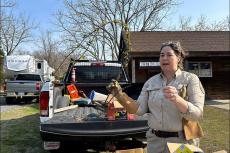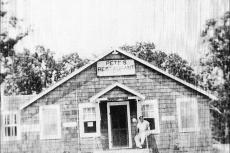A sign of the times, or of things to come? Near-hurricane level winds, tides, and rain blasted the East End on Monday, leaving downtown Montauk with far more damage than any other place in Suffolk County.
Many of the geotextile bags installed in the dunes by the Army Corps of Engineers about eight years ago lay exposed to the elements in the aftermath of the storm. It was “the worst I’ve seen it,” said East Hampton Town Supervisor Peter Van Scoyoc during Tuesday’s town board meeting.
“The waves were actually washing right up to hotels, right up the dune, the bank . . . I think, honestly, this is what we have come to expect more frequently,” he said. “These hundred-year storms, 500-year storms, you’re going to see more and more of them. That’s going to be one of the most challenging aspects of our coastal community — how do we balance coastal development with a need for those natural buffers? And our beaches — the beach itself is what really generates most of the economic energy and benefits to the town.”
The National Weather Service in Upton reported this week that Montauk received 2.5 inches of rain that day, the most of any hamlet or village in Suffolk County.
“It was a major coastal storm,” James Tomasini, a meteorologist based in Upton, said on Tuesday in reporting East End rainfall totals. Southold received 1.96 inches, Hampton Bays 1.9 inches, Orient Point 1.8 inches, Shinnecock Hills 1.8 inches, Gabreski Airport in Westhampton Beach 1.46 inches, and East Hampton 1.4 inches.
East Moriches and Southold weather observers reported the highest wind gusts in the county at 55 miles per hour, Mr. Tomasini said. Napeague registered 53 m.p.h., Montauk 47 m.p.h.
But over at the Montauk Lighthouse, Joe Gaviola, the keeper there, said the highest gust he recorded was 70 miles per hour, to go with 28-foot swells in Block Island Sound. To put that in perspective, Category 1-level hurricane winds start at 74 m.p.h.
“The rain was absolutely sideways, the winds hit almost hurricane force,” Mr. Gaviola said by phone on Tuesday. “What was upsetting to me was when I saw the wind was going to be south-southeast, I knew the beaches were going to be scoured. It’s unusual wind for this time of year from that direction.”
Fortunately, he said, the Lighthouse’s new stone revetment withstood the storm, working exactly as was intended. “We’re thankful that we have it. The amazing armoring didn’t blink one bit,” he said, “but it also tugs at me knowing the beaches took such a beating.”
Elsewhere in town, photographs of the new water-drainage channels alongside Stephen Hand’s Path suggest that that project is also fulfilling its intended purpose, with significantly less flooding than past storms caused at the road’s intersection with Route 114.
The winds and rain were so strong that power was lost at the East Hampton Airport. LTV’s public access channels went down, too, from Monday afternoon through Tuesday morning.
East Hampton Village closed Main Beach and Wiborg’s Beach out of safety concerns after rough surf knocked out about 400 feet of snow fencing, washing debris and sand into the parking lots.
All things considered, said David Collins, the village’s superintendent of public works, “We did great. We’ve been doing a lot of storm-drain maintenance, and I checked all the problem spots. We really did very well, considering how much water we had. It was nice to not have to deal with anything major.”
Farther west, Southampton Town Highway Superintendent Charlie McArdle said the weather uprooted a number of trees and clogged many storm drains. A manhole cover floated open with the influx of water on the Bridgehampton-Sag Harbor Turnpike where it meets Main Street in Bridgehampton. His department’s biggest problem, he said, was that the storm coincided with municipal leaf-pickup time. “When you get a heavy rain and the leaves fill the drains, it makes matters worse.”
“All in all, the town of Southampton did well,” Mr. McArdle continued. “We have a chronic problem at the Shinnecock Inlet. They spent lots of money to dredge it and put in lots of sand to protect the beach, and most of that washed away. Mother Nature gets pretty rough sometimes.”
As far as the Montauk beaches go, Mr. Van Scoyoc said he was “very pleased that FIMP [the Army Engineers’ Fire Island to Montauk Point program] is actually coming, and coming very soon . . . we’re going to need it very soon, but that’s not going to negate the longer-terms needs.”
“It was very apparent, standing down there by those hotels, that they’re not going to withstand a hurricane, if we get a major hurricane. . . . Those bags help, but any real surge and major hurricane is going to just wash right over them. So we need to continue working on our plans for adapting to that reality, because it’s coming, and it’s coming a lot faster all the time.”
With reporting by Christopher Walsh




